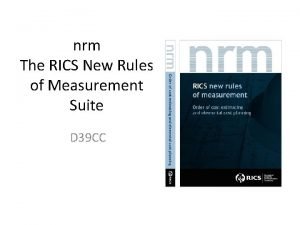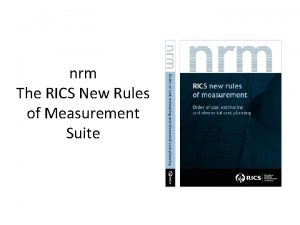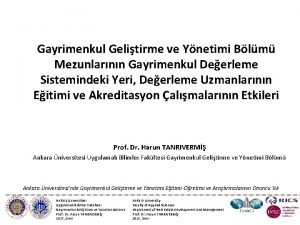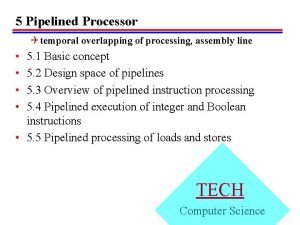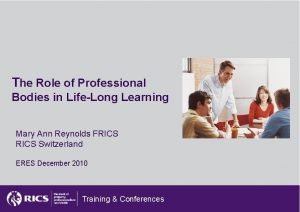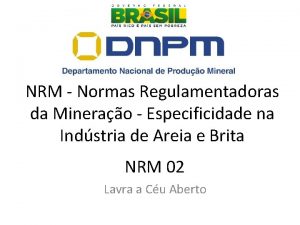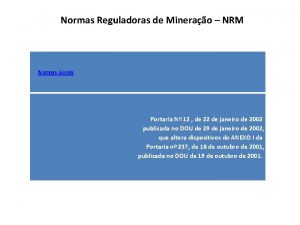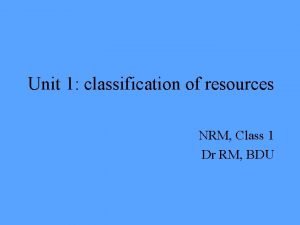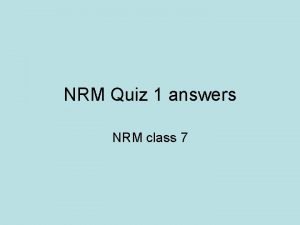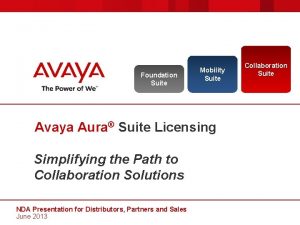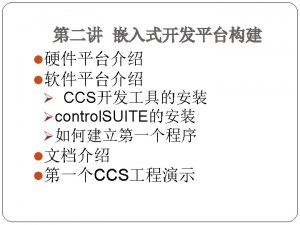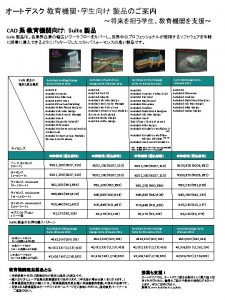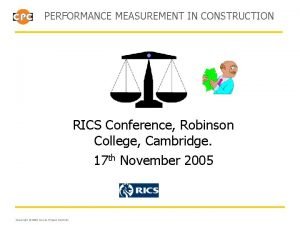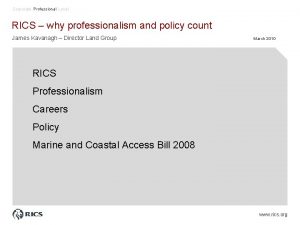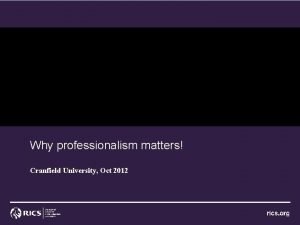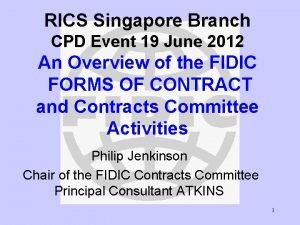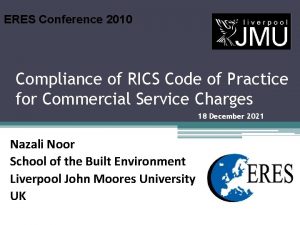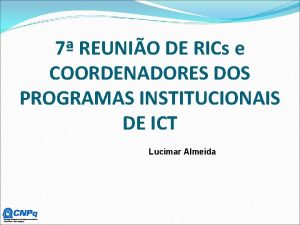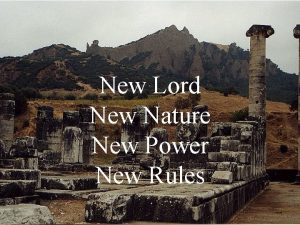nrm The RICS New Rules of Measurement Suite




























- Slides: 28

nrm The RICS New Rules of Measurement Suite






The RICS' new rules of measurement 23 March 2012 | By Stuart Earl • • • Meeting the challenge It is important to understand that the NRM is a toolkit for cost management, not just a set of rules for how to quantify building work. It provides guidance on: how measurement changes as the design progresses - from high level cost/m 2 or cost/functional units to more detailed measurement breakdowns of elements and subelements total project costs - how all cost centres can be considered and collated into the project cost plan risk allowances based on a properly considered assessment of the cost of dealing with risks should they materialise – dispensing with the use of the widely mismanaged concept of contingency total project fees - how fee and survey budgets can be calculated the design and survey information that a client needs at each RIBA Stage/OGC Gateway, for the QS to be able to provide more certainty in their cost advice the key decisions that clients need to make at each RIBA Stage/OGC Gateway a framework for codifying cost plans so they can be converted into works packages for procurement and cost management . http: //www. building. co. uk/the-rics-new-rules-of-measurement/5033890. article




NRM in context of RIBA Plan of Work and OGC Gateways



NRM Volume 2 • This volume, RICS new rules of measurement: bill of quantities for works procurement, provides fundamental guidance on the quantification and description of building works for the purpose of preparing bill of quantities and quantified schedules of works; it also provides a sound basis for designing and developing standard or bespoke schedules of rates. Direction on how to deal with items that are unquantifiable is also provided – e. g. preliminaries, overheads and profit, contractor designed works, risk transfer and fluctuations. • The RICS new rules of measurement: bill of quantities for works procurement provides a uniform basis for measuring and describing building works and embodies the essentials of good practice. • This First Edition will become operative on 3 January 2012 and is post dated accordingly.

Purpose of this document RICS new rules of measurement: bill of quantities for works procurement has been written to provide a standard set of measurement rules for the procurement of building works that are understandable by all those involved in a construction project, including the employer; thereby aiding communication between the project/design team and the employer. The document provides rules of measurement for the preparation of bill of quantities and schedules of works (quantified). The rules also provide a framework, which can be used to develop bespoke and standard schedules of rates. The RICS new rules of measurement suite of documents are based on UK practice but the requirements for a coordinated set of rules and underlying philosophy behind each section have worldwide application.

Structure of the document • Part 1 places the RICS new rules of measurement (NRM) suite of documents in context; places measurement for works procurement in context with the RIBA Plan of Work and the OGC Gateway Process; and explains the symbols, abbreviations and definitions used in the rules. • Part 2 outlines the benefits of detailed measurement, describes the purpose and uses of RICS new rules of measurement: bill of quantities for works procurement; explains the function of bill of quantities, provides work breakdown structures for bill of quantities, defines the information required to enable preparation of bill of quantities, describes the key constituents of bill of quantities, explains how to prepare bill of quantities; sets out the rules of measurement for the preparation of bill of quantities; and provides the method for dealing with contractors’ preliminaries, contractors’ overheads and profit, contractors’ design fees, other development/project costs, risks, inflation, and data gathering for supporting claims for tax incentives. • Part 3 comprises the tabulated rules for the measurement and description of building works for the purpose of works procurement.






Status of the RICS new rules of measurement These measurement rules have the same status as RICS guidance notes. The rules provide advice to RICS members on aspects of the profession. Where procedures are recommended for specific professional tasks, these are intended to embody ‘industry accepted and best practices’, i. e. Procedures which in the opinion of RICS meet a high standard of professional competence. Members are not required to follow the advice and recommendations contained in these rules. They should, however, note the following points. When an allegation of professional negligence is made against a surveyor or maintenance cost advisor, the court is likely to take account of the contents of any relevant guidance notes published by RICS in deciding whether or not the surveyor / maintenance cost advisor had acted with reasonable competence. In the opinion of RICS, a member conforming to the practices recommended in these rules should have at least a partial defence to an allegation of negligence by virtue of having followed these practices.

However, members have the responsibility of deciding when it is inappropriate to follow the guidance. On the other hand, it does not follow that members will be adjudged negligent if they have not followed the practices recommended in these rules. It is for each individual surveyor, or maintenance cost advisor, to decide on the appropriate procedure to follow in any professional task. However, where members depart from the practice recommended in these rules, they should do so only for a good reason. In the event of litigation, the court may require them to explain why they decided not to adopt the recommended practice. Also, if they have not followed this guidance, and their actions are called into question in an RICS disciplinary case, they will be asked to justify the steps they did take and this may be taken into account. In addition, guidance notes (and equivalent materials) are relevant to professional competence in that each surveyor, or maintenance cost advisor, should be up to date and should have informed him or herself of guidance notes within a reasonable time of their promulgation.

To conclude. . . . New Rules of Measurement The New Rules of Measurement (NRM) are a suite of documents issued by the RICS Quantity Surveying and Construction Professional Group. These have been developed to provide a standard set of measurement rules that are understandable to all those involved in a construction project. The rules aim to take a cradle-to-grave approach to the procurement of construction projects, and include cost estimating, works procurement and post-construction procurement. As well as covering the traditional costs that are reflected in measurable building work, the NRM encompass a range of other issues. These include overheads, profit and inflation, and other costs including consultants’ fees, land costs, and planning obligations. Guidance is also provided on dealing with tax allowances and grants. Part of the rationale for the new rules is to provide central governments, local governments and other public sector bodies with a value-for-money framework. More accurate cost estimation should also give reassurance to banks which are lending for construction projects. RICS supports the need to develop standard methods of measurement and reporting for sustainability across the property, land construction sectors through the use of the NRM. Although the NRM are based on UK practice, the basic principles should be applicable globally.

Key issues England • The Office of Government Commerce (OGC) and UK Government departments involved in construction procurement should use NRM as their standard model. • NRM are aligned with both the RIBA Plan of Work and OGC Gateway Process. • The NRM have the potential to reduce overspends that have affected many major construction projects. The role of Chartered Surveyors The QS and Construction Professional Group is the largest member group within RICS. Members have worked on the procurement and cost estimating aspects of construction projects throughout the world including the Beijing Olympics, Crossrail in London and the Burj al Arab hotel in Dubai.

Actions • The first set of rules that make up the NRM was published in February 2009 and covers order of cost estimating and elemental cost planning. Copies are available online via isurv http: //www. isurv. com/nrm or from RICS Books at http: //www. ricsbooks. com/product. Info. asp? product_id=17792. • 214 456 copies were downloaded between February and July 2009. • The RICS member working group will be producing two further volumes covering procurement and whole life costing. • RICS will be promoting the NRM to the OGC and other UK Government departments involved in construction procurement. • RICS Scotland recently produced research on the whole life costing of sustainable design.


 Rics rules of measurement
Rics rules of measurement New rules of measurement
New rules of measurement Fungiability
Fungiability Rics türkiye
Rics türkiye Carey comb murmur
Carey comb murmur Preserveing
Preserveing Référentiel cap rics
Référentiel cap rics Rics online academy
Rics online academy Nrm 02
Nrm 02 Nrm 19
Nrm 19 Moodle csag
Moodle csag Measurement standards laboratory
Measurement standards laboratory Hình ảnh bộ gõ cơ thể búng tay
Hình ảnh bộ gõ cơ thể búng tay Bổ thể
Bổ thể Tỉ lệ cơ thể trẻ em
Tỉ lệ cơ thể trẻ em Gấu đi như thế nào
Gấu đi như thế nào Glasgow thang điểm
Glasgow thang điểm Hát lên người ơi alleluia
Hát lên người ơi alleluia Môn thể thao bắt đầu bằng chữ đua
Môn thể thao bắt đầu bằng chữ đua Thế nào là hệ số cao nhất
Thế nào là hệ số cao nhất Các châu lục và đại dương trên thế giới
Các châu lục và đại dương trên thế giới Cong thức tính động năng
Cong thức tính động năng Trời xanh đây là của chúng ta thể thơ
Trời xanh đây là của chúng ta thể thơ Mật thư tọa độ 5x5
Mật thư tọa độ 5x5 Phép trừ bù
Phép trừ bù độ dài liên kết
độ dài liên kết Các châu lục và đại dương trên thế giới
Các châu lục và đại dương trên thế giới Thơ thất ngôn tứ tuyệt đường luật
Thơ thất ngôn tứ tuyệt đường luật
